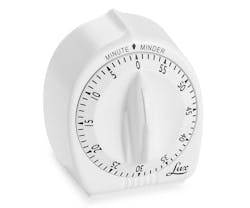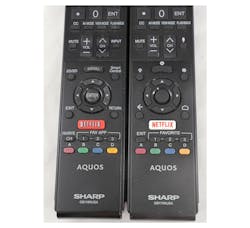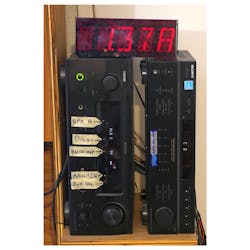Download this article in PDF format.
Back in 1989, engineer Reginald Neale wrote Bob Pease a letter complimenting him on his troubleshooting book. He agreed with Pease’s observation that modern test equipment has complicated menu structures. Neale then recommended Pease read the book "The Psychology of Everyday Things" by Don Norman.
A few months later in 1990, Pease replied in a handwritten letter:
“Okay, Reginald, I went out and bought the book, ‘The Psychology of Everyday Things’. Read it. Enjoyed it. I was confused because at the top of page 170 he thinks there’s confusion about those one-lever faucets. I think they are neat and natural. I can’t imagine how he or anybody else might be confused.
“I got another book in December, Systemantics, by John Gall. The plane running out of oil on pages 44 and 45 of Norman’s book is a perfect example. I’d love to tell there’s a lot more good stuff in Systemantics, but I think John Carroll excerpted about 40% of the better items. Still, about worth buying. I was disappointed that neither Norman nor Gall mentions the problems and solutions from the railroads of the 1890s. For example, a guy pulls a switch lever. He thinks the rail switch is thrown so the oncoming train won’t go into the siding full of cars of dynamite. But the cable broke and it didn’t move, crash. The solution was to set up a repeater. If you pull the lever and the tell-tale moves, you know the switch did move. It’s kinda fail-safe.
“Another example, the engineers kept screwing down the adjustments on the safety valve to get a little more steam pressure. Keep it up, and ‘boom.’ The solution was to set up two or three safety valves having two or three different designs. Put them inside and under a dome, so they are not accessible or adjustable. Another problem was a train going over a switch, and as soon as it’s through, the guy throws the switch to send the next train on the other route. But the guy blinks and throws the switch too early. The first train gets ripped apart. The solution was a sort of treadle to lock out the switch from being thrown until there is nothing on it.
“I mean, people figured out this kind of interlock 100 years ago. Now, at 3-mile Island, there was one valve closed that was required to be open, and its closure was largely responsible for the inability to understand and control the mess. They should have had an interlock, a repeater, on that kind of important valve. Neither author mentioned that. When systems get big and important, ya gotta plan ahead, and not just fix the accident after the crash. I mean, 70 years ago, the best way to fix airplane design was to wait for crashes and then make improvements. These days, it’s too expensive to be so dumb. PS: Neither author mentioned the special system for making sure parachute riggers do a perfect job.”
Puzzling Products
I completely agree with Pease and Neale. Many modern products are more of a puzzle than a useful appliance. Pease responded to the puzzle of computers by throwing one off the roof. Companies hire stylists and engineers, but no usability people.
1. The Schwinn Airdyne exercise bike has a control panel mounted between two swinging handlebars. The panel is hard to read and hard to understand.
I go to the local gym, and use a Schwinn exercise bike (Fig. 1). It is a complete abomination. Schwinn put the control panel between the two handlebars that swing back-and-forth while you pedal. If you need to press any buttons or change any settings, the metal arms are so close to each other that they beat your forearms away before you can touch the panel. Just as bad, the panel has minuscule printing. Pro-tip to exercise equipment designers: People don’t wear reading glasses when they exercise.
After three months, I managed to figure out you hit the lower center button to turn the dang thing on. Then you go to the button under the top display and press it so that it displays “level,” which is a little less arbitrary than “RPM.” Then you go to the button under the lower display and press that button until it shows time, not distance, which is completely arbitrary as far as I am concerned.
Not done yet, often the time is set to some non-zero value. So you use the far-left bottom button to zero out the time. Wait, wait… now you have to press the button to the right of it so that the timer starts to count up. The buttons are those cheap, carbon printed-circuit-board (PCB) types and some don’t work anymore. I never did understand what the two right-most buttons were until I took a picture, where I could blow it up and see those are “up” and “down.” There may have been paint on the embossed names once, but it has been worn off long ago.
2. The older Schwinn Airdyne exercise bike had a simple mechanical speedometer and odometer. (Courtesy of terapeak.com)
The really sad thing is the older versions of the Airdyne control box looks much more passive and far more understandable (Fig. 2). It had a mechanical speedometer with a mechanical odometer. I get that. I grew up seeing that in every car in the neighborhood. The LCD display is probably some type of time readout. The real horror is when I look at newer Airdyne models (Fig. 3). That control box looks like you are launching an Atlas rocket, not pedaling to go nowhere. What I really want is one of those mechanical egg timers (Fig. 4). Mount it nice and high so I can set it to five or ten minutes even when I’m pedaling. It will ding when I’m done.
3. The latest Schwinn Airdyne exercise bike has a control panel that is absurdly complicated. Like the older model at my gym, the panel is mounted between the swinging handlebars so you can’t touch it while you are pedaling. (Courtesy thefitnesssuperstore.com)
4. The Lux kitchen timer. I wish Schwinn would mount this on its Airdyne exercise bikes rather than some complex electronic control panel. (Courtesy Amazon.com)
Then there is the batch of Sharpie pens I bought (Fig. 5). They have a narrow tip on one end and a bold tip on the other. Sharpie calls it the Twin Tip, and sells them to this day. Problem is that when you go to put the bigger cap over the other end as you use the bold side, it wedges the little cap inside of it. If you have a dental tool handy, you can pry the little cap out. I have decided to lower my blood pressure by throwing my whole batch of Twin Tips into the garbage.
5. When you put the bigger cap on the back of a Sharpie Twin Tip marker, it wedges the smaller cap inside it.
I can’t believe the intelligent and successful people at Sharpie sat around a conference table and did not see that this marker has a serious design flaw. Just make the smaller cap a few millimeters less in diameter and the big cap won’t captivate it anymore. I guess those expensive injection-molding tools were already made and they dare not scrap them. Finance types have no forgiveness when it comes to their precious, precious money.
Pathetic Products
So many products are shabby or deficient these days. I think this has to do with the buyers at the retail companies. Decades ago, you could tell the products in the Sears catalog were decided on by people pretty much like you and me. They actually used the air compressors and garden tools and clothes, and they picked the best ones for the catalog. Now the buyers are just lowly peons in the eyes of the finance idiots that run companies. I don’t know who the buyers are, but they are not middle-class working people choosing things for other middle-class working people. If some Chinese knock-off is cheaper, then that’s what they buy. Keeping the finance clowns happy is more important than keeping customers happy.
6. The Arris DOCSIS modem has nine blue LEDs on the side. Some have completely cryptic labels.
My internet service is provisioned with an Arris DOCSIS modem (Fig. 6). The edge is peppered with little blue LEDs. They have jargon-cryptic labels like “MoCA” and “US/DS.” The labels are too small to read easily. It gives a little flashing light show as it hooks to the internet. The top has a mysterious button labeled “WPS.” There is an LED labeled “Power.” What is not clear is that the box has a battery. When the power light flashes, it means I accidentally flipped the wall switch and the box has lost ac power. It will work about a day, and then die. Cable company support misery ensues.
An SLJSoHID Approach
I would like to propose we start the Samuel L. Jackson School of Human Interface Design, or the SLJSoHID. Note that neither Mr. Jackson or his cadre of high-powered Hollywood lawyers knows or approves of this. Let’s hope his sense of humor exceeds his sense of brand protection. Samuel L. Jackson is known for playing characters who tell it like it is. He is a straight, if somewhat profane, talker.
The Arris DOCSIS modem designed at the SLJSoHID would have just one light and no power switch. When you plugged it in, that light would say “This %*&^ thing is plugged in.” It would say that in big, clear, high-contrast type that I could read across the room. When it’s doing all of its DHCP negotiations, I don’t want to see cryptic little blue lights flashing. I want the big lighted panel that said it was plugged in to now say, “This *~^%$ thing is warming up.” Yes, it’s like we have regressed to the vacuum tube age, as if electrical appliances have to heat up the filaments before they can work.
When the modem finally does actually hook me to the internet, I want that big lighted panel to now read, “This *&^%$ thing is working.” Spare me the jargon, spare me the gibberish. Just tell me if it’s working. For now I get that from the Ooma VoIP (voice over internet protocol) telephone box I plug into the modem. It has a big backlit daisy logo. When it flashes red, the internet is dead. When it turns blue, it’s connected.
7. The Ooma VoIP phone box has no explanatory text on it. The “buttons” are just touchpads that will go off if your hand gets even close to them. Apologies for the dust, but it’s impossible to clean unless you turn it off.
That Ooma VoIP phone box has another exasperating user interface (Fig. 7). Like modern hip and edgy designs, nothing is clearly written to tell you how to use it. Worse yet, it has hair-trigger touch buttons, so if you even brush near them, the phone goes off into some obscure function or mode. I routinely erase messages accidentally. I have yet to figure out some of the buttons, since I’m so terrified of turning the whole thing into a brick. It’s so touchy, it seems more like a training device for a bomb-disposal unit.
Hellish Handhelds
Speaking of bomb-disposal training devices, there are all of these handheld devices with buttons paving the sides. Designers must not realize that we all pick things up by the sides. My cheap flip phone has buttons at the lower part of its sides. My Nook tablet has buttons toward the upper part of its sides. Please, please put buttons in the top and bottom edge or the front, where we don’t grab to pick the dang thing up. I have yet to use my phone where I don’t somehow change the ring tone or vibrate mode, or change the volume.
That brings to mind an old Motorola phone I had. It blessedly used a standard USB connector. Then the engineers made it whereby the charger needed a resistor in the USB circuit, so you had to buy a Motorola charger. Modern industrial designers are all sadists or rent-seeking opportunists. Frank Zappa had an appropriate saying, "If there is a Hell, it waits for them."
Some usability issues are courtesy of the sociopath-in-chief, Steve Jobs. He pioneered the thinking that our products have to be so sleek and stupid they are impossible to understand. I also blame him for the widespread adoption of tiny dark gray text on black backgrounds for the few labels our products do have. Please universe, we are all aging. Please put some contrast in the labels as well as making displays that we can read without a magnifying glass. I hate having to take food packages to my 5-diopter reading lamp to read ingredients, nutrition info, or cooking instructions.
User-Unfriendly Interface
I don’t have to do any thinking or deep research to find miserable user interfaces. All I have to do is glance around the room. I have two 70-in. Sharp TVs. The remotes are obviously identical electrically. However, some sadistic genius has decided to take plain, simple English words off the newer remote (Fig. 8).
8. My older Sharp TV remote (left) has English labels like “2D/3D, MENU, Smart Central, ENTER, EXIT, and RETURN.” I defy anyone to understand the icons Sharp uses on the new remote (right). At least the Netflix button is more readable on the new remote.
When I worked at Ford Motor in the 1980s, we were forced into this kind of misery. The government had decided that we could only use icons to label heater controls, light switches, and other knobs. Ford argued that a word is a very handy icon, but the government refused. We tried to get permission to print the word under the mandated icon. The regulators denied that. Maybe by now everyone knows what the silly squiggly lines mean, but I would still prefer “Heat,” “Defrost,” and “De-Ice” than goofy little cartoons.
The Sharp TVs have their own menu exasperation. When I had a Samsung 46-in. TV in California, the optical-out audio jack would play 5.1 surround into my home-theater speaker system. In Florida, I have the exact same Denon receiver hooked to the exact same speakers. I could not get surround sound for a year.
The Denon manual is overly complicated and unclear to begin with. Even the hardware is goofy. The rear speakers might connect to the “Surround” jacks, or perhaps they are supposed to plug into the “Surr. Back/Amp Assign” jacks. It was the fact that I was not even getting the Dolby light on the receiver that tipped me off the TVs were not sending 5.1 over the optical-out cable. This was especially infuriating since the channel information overlay on the TV would say “5.1CH Dolby D.”
I plowed through the menus on the 4K TV and under the “audio” sub-menu found a setting titled “Surround.” When that didn’t work, I realized Sharp decided it was what they would name a pointless feature that simulates surround. They probably do phasing tricks on the built-in speakers to fake surround sound.
I use the older Sharp as a VGA computer monitor. I hooked it to a TV antenna so I could troubleshoot the surround sound while digging through its menu system. Its menus were cruder, but better-organized. Only then did I see that there was a “Devices” sub-menu. You had to go to the “Audio Out” sub-sub menu and then select “Optical,” which then let me choose between “PCM” and “Bitstream.” A tour through Google showed PCM tends to be a stereo standard, so I changed it to Bitstream. It only took me a year to figure this out.
The 4K TV had the same concept. I never noticed the “Devices” sub-menu since the new Sharp does not launch you into the top-level menu, but one level down in the “TV Setup” menu. Whoever designed this menu system must worship Satan. He must be trying to punish the world for teasing him in junior high school. Dear TV engineers, send 5.1 out the optical jack by default. People with optical input home-theater receivers do not want stereo. Also, please make setting up the TV part of the “TV setup” menu.
9. For a product that you use from 10 feet away, home-theater receivers have stupidly small displays. In addition, they display cryptic abbreviations and codes. The indicator labels were too tiny to read even up close. I solved this with masking-tape labels I can read from across the room. The old Sony stereo is the sub-woofer amplifier. At least its display is readable from across the room. Note the Alpha Five clock from Evil Mad Scientist. I can read that from across the house.
That Denon AVR-1609 receiver has its own exasperation. Like many other receivers, it’s huge. It measures over 6 by 17 in., yet the vacuum-florescent display text that tells you what the thing is doing is less than a quarter of an inch tall. Worse yet, the labels for some of the buttons are so minuscule I had to use a magnifying glass to read them. I solved that issue by putting masking tape on the panel. I wrote labels on the tape with the same Sharpie that so infuriated me earlier (Fig. 9). All of this was part of the chain of dependencies in troubleshooting why I didn’t have surround sound.
Image Unconscious
Years ago, I saw a Craigslist ad for a DSLR camera. The listing said “Brand new, too complicated to use.” I bought a cheap Dimage camera because it turns on with an actual switch, not a pushbutton. You slide the lens cover and it turns on. I adored this after my first experience with a little digital box camera in 2000. I pressed the “Power” button and nothing happened. Fortunately my young protégé Francis Lau was nearby. Being younger and hipper to the ways of user interface evil, he showed me that you had to hold down the power button for about a half-second before it would turn on. Of course, if you held it down for too long, it would turn on, see that you were pressing the power button, and then turn off.
While the Dimage slide on-off switch is great, the menu system on the Dimage is laughable. The default selections are almost all wrong. One default is to turn the camera off after a minute. Another default is to reset any setting you may have laboriously set when it does turn off. My fancy 4K Panasonic GH4 has a gigantic menu system and assignable pushbuttons peppering the back. It’s beyond bad and gets to the point of absurdity.
From the Sublime to the Refrigerator
I bought a Roundup-brand sprayer (Fig. 10). It drives me nuts. The plastic plunger is cheap and flimsy. There is no pressure-release valve. The sprayer valve is horrific. It takes about a second to turn off. You have to be sure the chemical spray has stopped or you accidentally kill large swathes of grass. If you are not careful, it locks, so it never turns off.
10. This Roundup-brand sprayer has a flimsy pump that makes an awful squeak when you use it. The spray valve sticks so it takes a second to stop spraying. There is no pressure-release for when you want to store it or add chemicals. If you lock the handle 180 degrees off, the wand holder interferes with the hose outlet.
When I went to buy more Roundup chemical, a helpful store employee noted that HDX Weed and Grass Killer was half the price, and you use half the amount to make a gallon of spray chemical. I promptly bought it. It was not so much to save money, but to punish the otherwise fine folks at Monsanto for selling that junk sprayer.
Meanwhile, my 2300-dollar Samsung refrigerator has Wi-Fi so I can spend a couple hours setting it up to communicate with a smart electric meter. This might save 20 cents of electricity a month. I don’t want to turn off my refrigerator at peak usage times. Food safety is more important to me than saving less than three bucks a year. If Samsung has to go high tech, they should put in a barometric pressure sensor so that you can set the refrigerator temperature to 0.2°C above freezing, no matter the altitude or weather.
Many of my pals collect old test equipment, ham gear, and consumer electronics. The old stuff just has a more intuitive user interface, augmented by clear labels. I have an old Sharp microwave from the 1970s that has a mechanical timer dial and a start button. When you open the door, it turns off. It’s blessedly analog and blessedly simple.
Software usability is atrocious, but I recently downloaded FreeCommander to use instead of Windows Explorer. I did this after noting that Windows Explorer would just close by itself. It turns out that if I left it pointed to a USB device that shuts off, like that Dimage camera, Windows Explorer just goes “poof.” FreeCommander just hops up a level. I love it. Things can be intuitive and usable even in this day and age.
Since the Baby Boom has aged, maybe we can look forward to products with clear and simple interfaces. Let’s hope designers learn we are longing for big print with sharp contrast. We want switches, not pushbuttons that might turn the gizmo on, or might turn it off. At the least, use two push-buttons, one for on and one for off, like Denon does on its remote. Maybe if we all rise up and complain, the billion-dollar multinational product companies will fire the stylists and interior decorators and hire some usage architects. Then we won’t need to read 60-page manuals every day to remind us how to operate our household appliances.
About the Author

Paul Rako
Creative Director
Paul Rako is a creative director for Rako Studios. After attending GMI (now Kettering University) and the University of Michigan, he worked as an auto engineer in Detroit. He moved to Silicon Valley to start an engineering consulting company. After his share of startups and contract work, he became an apps engineer at National Semiconductor and a marketing maven at Analog Devices and Atmel. He also had a five-year stint at EDN magazine on the analog beat. His interests include politics, philosophy, motorcycles, and making music and videos. He has six Harley Sportsters, a studio full of musical instruments, a complete laboratory, and a video set at Tranquility Base, his home office in Sun City Center Florida.











